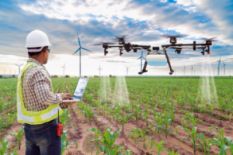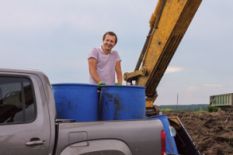Any building rests on a foundation. The foundation stands on the ground. The stability of the whole structure depends on the bearing capacity of soil. But what if calculations proved wrong or there was force majeure?
– Could you start by describing the technology?
We used Uretek as a base technology for geopolymer deep injection, which was developed in Finland back in 1978. As far as the physics of the process is concerned, polyurethanes and polyols mix with a hardener, which, having entered into a reaction, expands 30 times within 12-18 seconds and hardens into a kind of monolith. A mixture of polymers and a solvent is a liquid resin, which easily penetrates the ground and fills all voids.
The properties of geopolymer composite can be described as solid, durable, stable, flexible, hardly prone to mechanical stress and quite wear-resistant. In addition, this material is hydrophobic and oleophobic, which expands the possibilities of its use for raising and stabilizing sinking support structures on flooded soil or chemically polluted soil.
– And what can cause the sinking?
There can be various reasons. For example, there was a mistake in the calculation of the bearing capacity of the foundation during the design of a building because the weight and vibration of production equipment or wind and snow loads were not taken into account. Often, soil loosening is caused by (it should be noted that collapsible soils are predominant in Ukraine) groundwater or underground rivers.
But even with accurate calculations and compliance with all building codes, no-one is immune from the interference of external factors: a building built nearby influenced the flow of groundwater or something disturbed the integrity of underground utilities and a leakage in the pipes occurred. As a result, the foundation begins to sag, and often unevenly, which causes the structure to tilt. And this becomes a serious problem, especially for industrial facilities.
– So, does your technology of stabilizing support structures in industrial buildings enjoy the highest demand?
In general, geopolymer injection technology can be used for structures serving various purposes. The cases in our portfolio mostly concern the restoration of soil under the foundation of industrial premises and slabjacking at airports, ports, roads and logistics centers. But we also work with private households – the scale of the project and the quality that guarantees the reliability of the work performed is important for us.
– How does geopolymer injection differ from traditional methods of stabilizing sinking support structures?
Our technology does not require digging or excavation. That is, you do not have to de-install expensive equipment and look for a place to store it temporarily, you do not need to empty the room, remove the slabs and dig out the foundation, wait for the concrete to harden (if concrete is used), and then do all the same in the reverse order. The material expands, becomes dense and causes the surrounding soil to become dense due to its expansive qualities, and not pressure, when it is injected.
If we are talking about continuous production, suspending the operation for such a period of time inflicts significant losses on the business. We work quickly, silently, locally, and do not interfere with anyone. Neither do we ask to clear the floor from any load. Moreover, it is better to even increase the load so that, under pressure from above, the resin penetrates as deep as possible into the soil. All we need is to drill a hole of only 12-16 mm in diameter to pump an expanding polymer through the pipe directly into the ground.
– Obviously, the works are preceded by serious calculations?
To determine the density of soil and its geomechanical properties, we use dynamic sounding and draw up a work plan indicating weak spots, voids and sinking places. However, geopolymer injection is a very complicated process because we do not really see what is happening under the foundation. Therefore, our specialists strictly monitor the situation in the room and known when to stop thanks to their experience and competence.
– What immediate tasks and goals have you set for the company?
We are on the verge of rebranding. Over the seven years of active operation, we have accumulated a huge portfolio of projects and profound experience. We have developed our own vision of technology, so we want to position ourselves in the market and develop further as a new independent brand REDIT.
– How do you see the brand REDIT in 10 years?
I would like to expand the range of the company's services to ensure that the brand REDIT meets all customer needs related to the use of polyurethanes and polyols in construction.
Interview by Natalia Kyrylenko.
Photo: provided by Тaras Bogachev.









